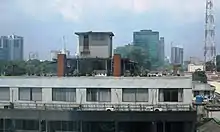22 Gia Long Street
22 Gia Long Street, now 22 Lý Tự Trọng Street, is an apartment building in Ho Chi Minh City (also known as Saigon), the largest city in Vietnam. In 1975, photojournalist Hubert van Es, working for UPI, captured an iconic photo of U.S government employees evacuating the city by helicopter during the Fall of Saigon, the last major battle of the Vietnam War. The evacuation was code named Operation Frequent Wind. The image was widely misreported as showing Americans crowding on to the roof of the United States Embassy to board a helicopter.[1][2] In reality, the apartment complex, called the Pittman Apartments, housed employees of the United States Agency for International Development (USAID), with its top floor reserved for the Central Intelligence Agency's deputy chief of station; the embassy was located at 4 Thống Nhất, about 950 metres (0.59 mi) to the south-southeast.[3] The photo depicts an Air America Huey helicopter landing on the roof of the elevator shaft to evacuate employees of the U.S. government as North Vietnamese Army troops entered Saigon.[2]


At the end of the war, Saigon was renamed Ho Chi Minh City, and Gia Long Street was renamed Lý Tự Trọng Street, in honor of a 17-year-old communist executed by the French. Visitors are allowed access to the roof by taking the elevator to the 9th floor.
References
- Bradsher, Keith (15 May 2009). "Hubert Van Es, Photojournalist, Is Dead at 67". The New York Times.
- Butterfield, Fox; Haskell, Kari (23 April 2000). "The World; Getting It Wrong in a Photo". The New York Times.
- Es, Hubert van (29 April 2005). "Thirty Years at 300 Millimeters". The New York Times.
External links
- Tucker, Reed (23 April 2019). "Almost everything you thought about the famed Fall of Saigon photo isn't true". New York Post.